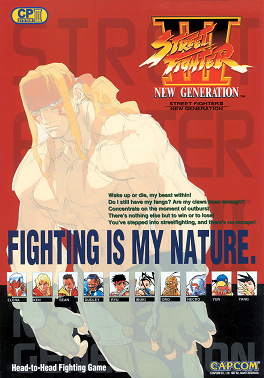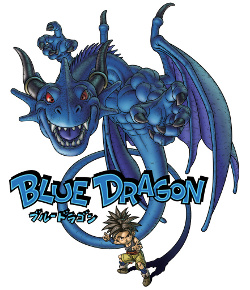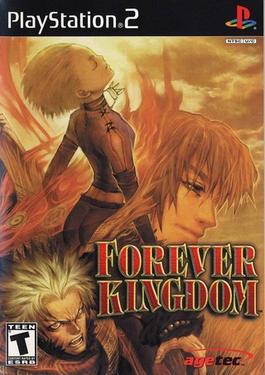
Street Fighter III: New Generation is a 1997 fighting game in Capcom's Street Fighter series, originally released as a coin-operated arcade game. The game, which was designed as a direct sequel to Street Fighter II (1991), initially discarded every previous character except for Ryu and Ken, introducing an all-new roster led by Alex. Likewise, a new antagonist named Gill took over M. Bison's role from the previous games as the new boss character.

Riviera: The Promised Land is a role-playing video game originally produced in 2002 by Sting Entertainment for WonderSwan Color as the first episode of the Dept. Heaven series of games. The game was later introduced to Nintendo's Game Boy Advance in 2004, which Atlus USA released in North America in 2005. An enhanced remake was released for the PlayStation Portable in November 2006, and was released in July 2007 in North America by Atlus USA. In July 2023, an HD remaster was announced for Microsoft Windows, Nintendo Switch, iOS and Android. The HD remaster released on Steam in July 2024.

Blue Dragon is a role-playing video game developed by Mistwalker and Artoon in collaboration with Microsoft Game Studios Japan and published by Microsoft Game Studios for the Xbox 360. Blue Dragon is based on a design by Final Fantasy series creator Hironobu Sakaguchi, who also supervised development and wrote the plot. It is both Mistwalker's debut title and the first title to be helmed by Sakaguchi outside of Square Enix.

Panzer Dragoon Saga, known in Japan as Azel: Panzer Dragoon RPG, is a 1998 role-playing video game (RPG) developed by Team Andromeda and published by Sega for the Sega Saturn. The third entry in the Panzer Dragoon series, it replaced the rail shooter gameplay of the previous games with RPG elements such as random encounters, semi-turn-based battles and free-roaming exploration. The player controls Edge, a young mercenary who rides a dragon and encounters a mysterious girl from a vanished civilization.

Fire Emblem: Path of Radiance is a 2005 tactical role-playing video game developed by Intelligent Systems and Nintendo SPD, and published by Nintendo for the GameCube. It is the ninth main installment in the Fire Emblem series, and the third to be released in the west. As with previous installments, gameplay revolves around positioning characters on a battlefield to defeat an opposing force. If characters are defeated in battle, they are removed from the rest of the game.

Valkyrie Profile is a role-playing video game developed by tri-Ace and published by Enix for the PlayStation. It was released on December 22, 1999 in Japan and on August 29, 2000 in North America. Inspired by Norse mythology, Valkyrie Profile follows the titular valkyrie, Lenneth, as she travels through Midgard, collecting the souls of slain heroes to serve either as einherjar or her personal companions for Ragnarok - the battle to decide the fate of all creation - and trains them by fighting monsters and performing additional quests. As she journeys, she learns more about her original human life, removed from her memory upon becoming a Valkyrie.

Stella Deus: The Gate of Eternity is a 2004 tactical role-playing game co-developed by Atlus and Pinegrow for the PlayStation 2. It was published in Japan and North America by Atlus, and in Europe by 505 Games. The gameplay, which is similar to that of Hoshigami: Ruining Blue Earth, has the player controlling six characters through story-driven tactical missions, revolving around positioning, assigned equipment, and the special skills of individual characters. The story focuses on Spero, a young man who is caught in the middle of a growing conflict between various religious factions, which in turn are being spurred by the advance of the Miasma, a force that will destroy all life.

Tales of Mobile is the collective name of several mobile phone-based games, available only to Japanese NTT DoCoMo FOMA 900i cellphone users. The games often feature characters and story elements from the popular Tales role-playing video game series. As these games are offered as a download-only phone service in Japan, none of them have been made available outside Japan.

Forever Kingdom, known in Japan as Evergrace II, is an action role-playing game released for the PlayStation 2 by FromSoftware. It is the prequel to Evergrace.

Evolution Snowboarding is a 2002 snowboarding video game both developed and published by Japanese game company Konami. The game takes a new perspective on the snowboarding genre. It is the sequel to Evolution Skateboarding.

Luminous Arc is a tactical role-playing game developed by Imageepoch for the Nintendo DS, and the first in the Luminous Arc series. The game was released on February 8, 2007 in Japan, August 14, 2007 in North America, and October 18, 2007 in Australia by Atlus, and in Europe the following day by Rising Star Games.

Bloody Roar Extreme, or Bloody Roar: Primal Fury as it is known outside of its Japan release for the GameCube, is a fighting game developed by Eighting released in 2002 for the Nintendo GameCube. It was later ported to the Microsoft Xbox under the original moniker of Bloody Roar Extreme in 2003.

Hoshigami: Ruining Blue Earth Remix, also known as simply Hoshigami Remix, is a strategy RPG video game, for the Nintendo DS and is a remake of Hoshigami: Ruining Blue Earth for the Sony PlayStation. The game was developed by Arc System Works and was released in Japan in May 2007 by ASNetworks and in North America in June 2007 by Aksys Games. The developed programmer is Barnhouse Effect, and characters are designed by Arc System Works.

Blue Wing Blitz (ブルーウィングブリッツ) is a Japanese-exclusive tactical role-playing game developed and published by Square on July 5, 2001 for the WonderSwan Color and compatible with the WonderSwan.

The Lord of the Rings: War in the North is a 2011 action role-playing game developed by Snowblind Studios and published by Warner Bros. Interactive Entertainment for PlayStation 3, Xbox 360, and Microsoft Windows. An OS X port was developed and published by Feral Interactive in 2013. It is the first video game based on both J. R. R. Tolkien's 1954 high fantasy novel The Lord of the Rings and Peter Jackson's film trilogy adaptation released in 2001, 2002 and 2003. This is because, until 2009, Vivendi Universal Games, in partnership with Tolkien Enterprises, held the rights to make games based on Tolkien's literary works, whilst Electronic Arts held the rights to make games based on the New Line Cinema films. In 2009, WB Games acquired the rights for both intellectual properties.

Capcom Fighting Jam, released in the US as Capcom Fighting Evolution, is a 2004 head-to-head fighting game from Capcom. It was originally released as a coin-operated arcade game for the Namco System 246 hardware and ported to the PlayStation 2 and Xbox. The game features characters from three different incarnations of the Street Fighter series, as well as characters from the Darkstalkers series and the CPS III arcade game Red Earth, with each character employing the fighting system from the game which they represent.

Super Gem Fighter Mini Mix, also released as Pocket Fighter, is a 1997 fighting game developed and published by Capcom for arcades. The game uses the same super deformed character designs previously used in Super Puzzle Fighter II Turbo, a puzzle game by Capcom. It was ported in 1998 to the PlayStation, which retained the Pocket Fighter title for its North American and PAL releases, and then the Sega Saturn and WonderSwan, both in Japan only.
Guilty Gear is a series of fighting games by Arc System Works, created and designed by artist Daisuke Ishiwatari. The first game was published in 1998, and has spawned several sequels. It has also adapted to other media such as manga and drama CD. Guilty Gear has generally received praise from video game reviewers for its highly technical gameplay, graphics, soundtrack, and for its characters. Another fighting game franchise by Arc System Works, BlazBlue, is considered a spiritual successor of the series.

Assassin's Creed Identity is an action-adventure video game developed by Ubisoft Blue Byte and published by Ubisoft. It is a spin-off installment of the Assassin's Creed series, and takes place alongside the events of Assassin's Creed: Brotherhood. In the game, players assume the role of a customisable Assassin known as Lo Sparviero and carry out various missions in Italy to weaken the control of the Templar Order, led by the villainous Borgia family. The main storyline revolves around the Assassins' conflict with a mysterious organization known as "the Crows", who can perfectly mimic their skills and techniques.

Dynasty Warriors: Godseekers is a tactical role-playing game developed by Omega Force and published by Koei Tecmo. The game is a spinoff to the Dynasty Warriors series of video games that focuses less on action, and more strategy, similar to prior spinoff Dynasty Tactics. The game was released on the PlayStation Vita and PlayStation 4 video game consoles in the West, with a PlayStation 3 port existing only in Japan.


















